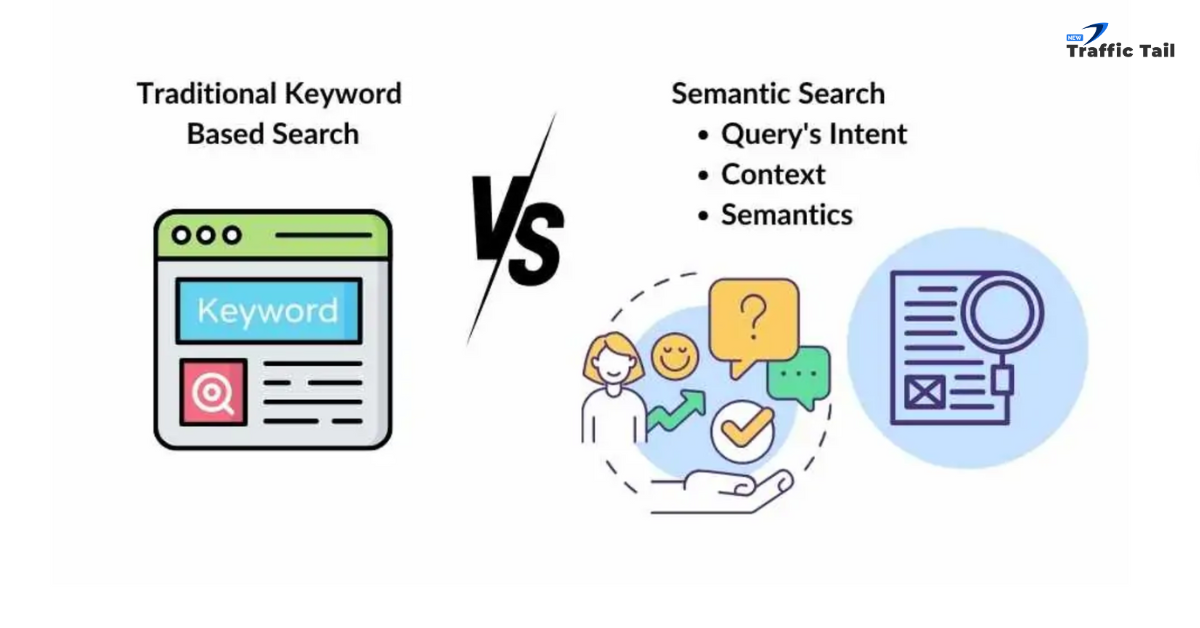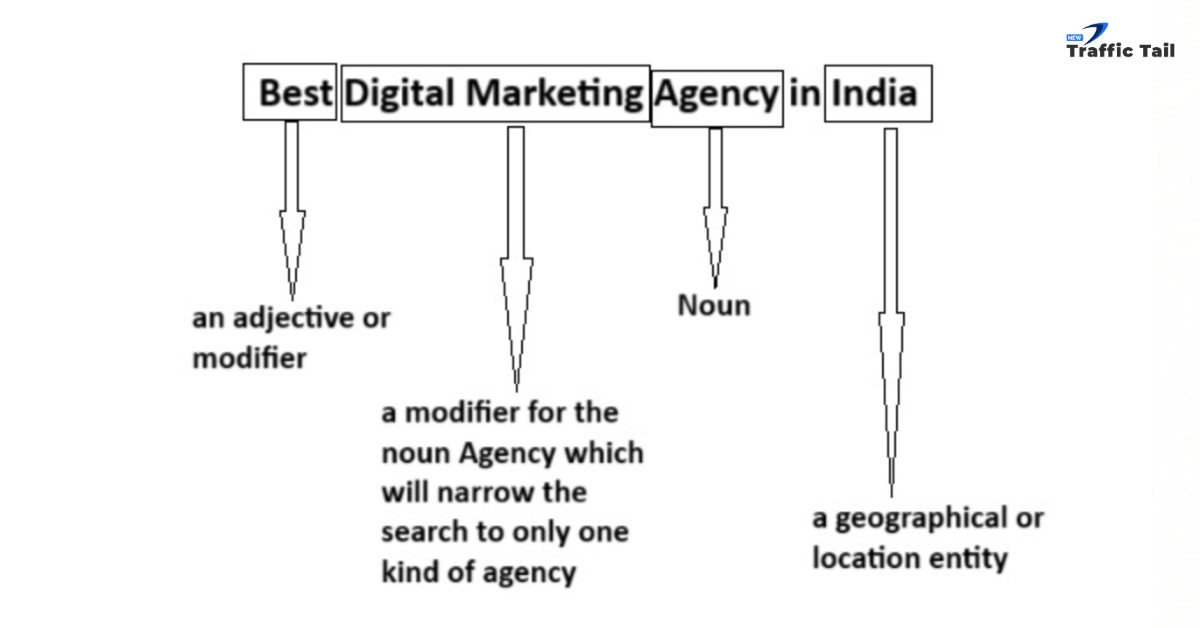Have you ever wondered how Google or any other search engine finds the answer to your queries? Whether you type a single word or a long question, it will bring you the best results with relevant content and webpages. It seems like the search engine reads our minds when we put our search queries. This is all possible due to a technology called Semantic Search.
In the past, search results were based only on the keyword. Therefore, users might not find what they wanted in actuality. But, semantic search technology has completely changed how we interact with search engines.
In this blog, we’ll describe what semantic search is, how it works, and other related concepts. So, stay tuned!

👉Terms Related to Intent-Based Search Technologies
✔️ Contextual Search: It is a smart way by which search engines learn the context or concept of the user query using natural language processing (NLP) systems. For this purpose, they take into account the users’ search history and online footprints to bring the best relevant results to them and make searching more helpful.
✔️ Intent-Based Search: This search engine system works to understand what users truly want to achieve from their search requests. It does not rely on simple keyword matching but detects what its users truly wish to find. The system understands user objectives regardless of the query type. Users can perform intent-based searches on online shopping platforms.
✔️ Natural Language Processing (NLP): This is an artificial intelligence (AI) technology that helps computers understand human language, using algorithms and machine learning techniques. Semantic search engines and chatbots use this technology to understand what a user is asking for.
✔️ Machine Learning: It is an artificial intelligence technique through which computers learn to improve their performance using the available data without any additional programming.
✔️ User Intent: It is a user’s main objective or goal behind any search query.
✔️ Lexical Search: Lexical Search or keyword search is a technique used by search engines to provide search results solely by keyword matching. This does not include learning about the real idea or intention for a searched query.
✔️ Sentiment Analysis: Search engines run algorithms to find out the real motive, thought, or concept for a user query, which is known as sentiment analysis.
✔️ Keyword Stuffing: Users place specific keywords in their content to improve their online rankings. When they overuse a keyword in a webpage’s content, it is called keyword stuffing. Nowadays, keyword stuffing is prohibited as it can negatively impact the online reputation.
What is Semantic Search Technology?
Search engines use contextual search to go through data using machine learning algorithms and natural language processing (NLP) and showcase accurate search results after understanding the users’ purpose behind the search. This approach is also applied in other applications, i.e., chatbots and content management systems.
This enhances the quality of information by the search engine after perceiving the context behind the input search query, not by matching the keywords only. It finds the actual meaning of words used and offers the most related content.
Sometimes, a query may have multiple meanings, but the search engine grasps the users’ real aim behind it and shows the information as per their needs. This approach has improved the overall user experience while searching on the web.
What Is the Mechanism Behind Semantic Search?
This approach utilizes various machine learning processes, like NLP, to provide the best results for a search within seconds. It decodes the keywords and comprehends the user’s objective. However, it is a complex mechanism, including multiple steps as follows.
Step 1: Understanding the Search Query
First, the search engine interprets the context of the input question or phrase. Using NLP, it examines the sentence or keyword phrase and analyzes how words are connected. The search engine parses the whole sentence into single entities. This helps it apprehend the query better.
Step 2: Search Engines Recognize the Entities
Semantic search engines perform identification and categorization tasks for entities that lead to classification into places, things, people, and ideas. The search engine strives to interpret the user’s original idea within their initially asked question. Through the mapping process, each entity receives a synonym or meaning analysis, and the search engine expands its search range.
Step 3: Analysis of the Concept Behind the Input Keywords.
The sentiment search technology uses its inspection processes on input keywords to detect underlying user sentiments and intentions. On the basis of user search history and location data, with past choices, the platform selects suitable answers.
Step 4: Offer Search Results Through Semantic Indexing
The search engine utilizes its semantic algorithms to process keywords with stored content through understanding the search parameters. The rankings of webpages combine with their relevant content to offer the most suitable results. Web rankings rely on more than one factor because they consider authority values together with content relevance. SEO link-building practices with different methods enable users to achieve higher rankings on search engine results pages.
Understanding Sentiment Search Mechanism with an Example
Here’s an example of how to understand the working pattern of meaning-based search technology.

Let’s say we put a query “Best Digital Marketing Agency in India” in a search engine.
- First, it will parse the sentence into different parts of speech. For example, “Best” is an adjective or modifier for the noun “Agency”. Additionally, the word “Digital Marketing” is also a modifier for the noun Agency which will narrow the search to only one kind of agency.
- After that, these words will be categorized into several entities, including places, people, or organizations. Here, in the example, the search engine will categorize “India” as a geographical or location entity.
- Then, the search engine will start semantic analysis to find the most accurate and relevant results, including synonyms and related concepts for expanded search. For example, it can show results for digital marketing companies or service providers, which are synonyms for the word Agency. Similarly, it will show content having data from all over India. It can be a digital marketing company from any city or town that has relevant content.
- Finally, the search engine will consider the websites or webpages with higher rankings and related content. These can be the lists of various reputed digital marketing agencies or a blog related to a single company from a specific city.
Semantic Search Vs Traditional Search Techniques
Contextual Search Technology |
Traditional Keyword Search |
|
|
|
|
|
|
|
|
|
|
Positive Sides of Contextual Search
It is convenient when the search engines show accurate information for a query. This has only been possible with the semantic search technology. Here are the various benefits of contextual search.
- The foremost advantage of this search technique is the improved search results. The data results are more relevant and appropriate as per the user’s intention and needs. As we know, this technology uses user preferences, location, and keywords’ meaning to offer the best results. For example, if a user searches for “Schools near me”, it would show results including schools in the user’s specific geographical area.
- Being capable of recognizing natural human language, contextual search engines offer exactly what users want. This approach has enhanced the user experience for surfing the internet. It allows users to search for whatever they want to know in their common language.
- Semantic search algorithms are designed to comprehend users’ language and logic even when trends change. They learn the latest linguistic expressions and slang to adjust their response to the users’ queries.
- Intent-based search engines go through a large database and content to showcase the best matches based on the context and intent of the query. This provides the most reliable and efficient information to users faster than traditional lexical search techniques.
- The contextual search approach supports many languages, improving search engines’ accessibility. It also offers speech-to-text and text-to-speech features to search for any query. This approach has made search engines easy to use for even those who can’t read or write.
Natural Language Search: Affecting SEO
Modern intent-based search has affected search engine optimization (SEO) and its methods. Earlier, publishers used keyword stuffing as a common tactic to improve the SEO of a content piece. However, one may get penalties from semantic search engines for overusing keywords nowadays, as it is an outdated strategy. They consider various other factors to improve the content’s SEO.
Search engines analyze whether the content is beneficial, reliable, and relevant. They look for quality content to satisfy users searching for online information. Contextual search has made SEO more than keyword cramming and stuffing. Additionally, it has made content easier to rank for long-tailed keywords, which was highly difficult in the past. Now, search engines can understand long phrases and decode them to provide the related, accurate results.

A Technology to Make the Search Experience Convenient and Better
All in all, semantic search technology has made our search journey easier and improved. No matter what you type to search, it will fetch the best data to satisfy your needs. It exceeds the traditional lexical search and realizes the real intention behind a search query.
Using NLP and machine learning, contextual search acknowledges the meaning and context of the input keywords. The modern sentiment search techniques have completely transformed how we access information from search engines.
Therefore, Google is also working on its algorithms to better understand human queries and provide more 100% accurate search results.
Additional Readings for Enhanced SEO Strategies:
- ✍️ PPT Submission Sites
- ✍️ Profile Creation Sites
- ✍️ Article Submission Sites
- ✍️ Social Bookmarking Sites
- ✍️ PDF Submission Sites
- ✍️ Image Submission Sites
- ✍️ Directory Submission Sites
- ✍️ Ping Submission Sites
- ✍️ Web 2.0 Submission Sites
- ✍️ Search Engine Submission Sites
- ✍️ Local Citation Sites
- ✍️ Classified submission sites
FAQs
Q1: What is machine learning?
It is an AI-based technology that runs algorithms to learn and understand data and its patterns to predict or recommend something to a user. It involves recognizing speech, images, and text formats to offer search results.
Q2: Is voice search a part of contextual search?
Yes, intent-based search technology also involves speech recognition features, which help users search for their queries without typing.
Q3: How can intent-based search help businesses?
It has helped businesses have a higher click-through rate (CTR), conversions, and sales by ranking higher in local search results.




